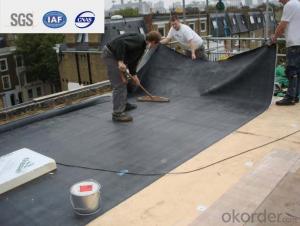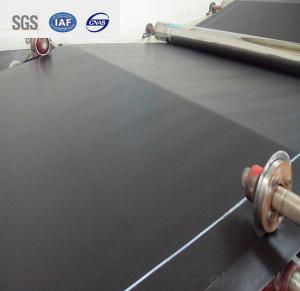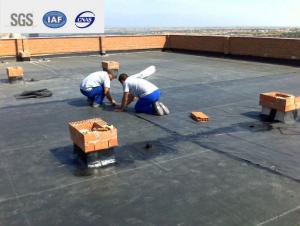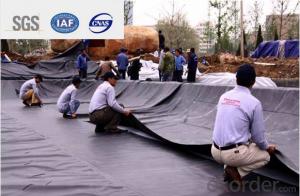EPDM Self-adhesive Waterproof Membrane for Rooftop 1.5mm
- Loading Port:
- Qingdao
- Payment Terms:
- TT OR LC
- Min Order Qty:
- 2000 m²
- Supply Capability:
- 800000 m²/month
OKorder Service Pledge
OKorder Financial Service
You Might Also Like
Description Of EPDM Rubber Waterproof Membrane:
1. EPDM waterproof membrane is made from ternary ethylene-propylene rubber, which is for waterproofing of exposed and non-exposed applications.
2. EPDM waterproof membrane production adopts the world-advanced equipment of cold feeding extrusion and continuous vulcanization technology.
3. EPDM waterproof membrane is of high elasticity among high polymer waterproof materials and becomes a world-popular waterproofing material.
Main Features of EPDM Rubber Waterproof Membrane:
1. Excellent physical and mechanical performance
2. High tearing resistance
3. Good deformation adaptability
4. High puncture resistance
5. High aging resistance
6. UV resistance
Specifications of EPDM Rubber Waterproof Membrane:
Material | EPDM Rubber |
Size | 1.2m (width)*20m (length) or customized, weldable type 2.05m or 4m width |
Thick | 1.2mm, 1.5mm, 2.0mm |
Type | Vulcanized & Weldable |
Pattern | Non-reinforced (homogeneous) |
Certificate | ISO9001/14001 |
Applications of EPDM Rubber Waterproof Membrane:
1.Roofs, Basement, Toilets
2. Industrial and civil building waterproofing
3. Geosynthetic liner for swimming pool, channels, irrigation system
4. Especially suitable for projects with high requirements in durability, anti-corrosion and deformation.
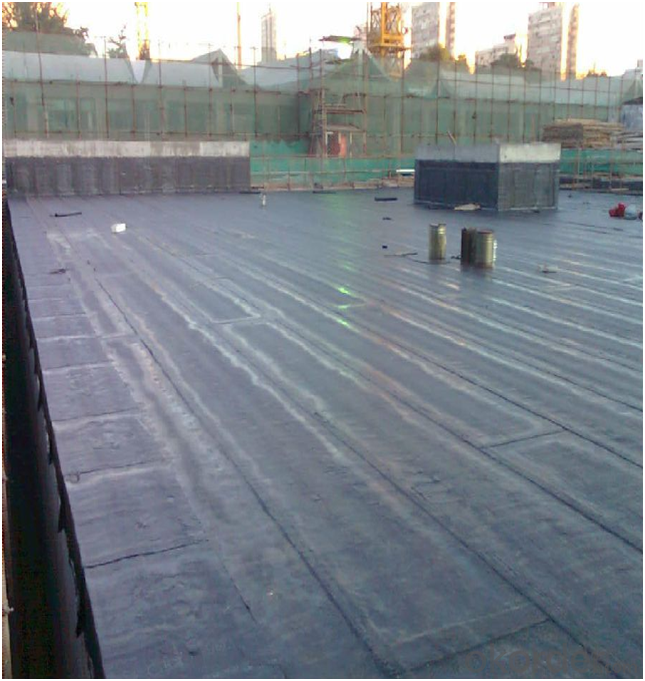


FAQ:
1. What are we supplying?
We are specialized in producing Colorful Asphalt Roof Shingle, SBS/APP modified bitumen waterproof membrane, Self adhesive bitumen waterproof membrane, PVC waterproofing membrane, EPDM rubber roofing membrane, Single Component Polyurethane Waterproof Coating, and Spray Polyurea Waterproof Coating.
2. How Many years experience do we have?
We have been exported to more than 20 countries in the past 15 years.
3. How long do we usually reply your request?
We always reply our customer within 24 hours.
- Q:Are waterproofing membranes suitable for indoor applications?
- Yes, waterproofing membranes are suitable for indoor applications. They are commonly used in areas such as bathrooms, basements, and kitchens to prevent water damage and moisture penetration. Waterproofing membranes provide an effective barrier against water and can help protect the structural integrity of buildings in indoor environments.
- Q:Can a waterproofing membrane be used in planters or garden beds?
- Yes, a waterproofing membrane can be used in planters or garden beds to prevent water leakage and protect the surrounding areas. It helps to retain moisture in the soil and prevents water damage to the planter or garden bed structure.
- Q:Can a waterproofing membrane be used on below-grade foundations?
- Yes, a waterproofing membrane can be used on below-grade foundations. Waterproofing membranes are commonly used to prevent water infiltration and protect the foundation from moisture damage in below-grade applications.
- Q:Can a waterproofing membrane be used in hospitals or healthcare facilities?
- Waterproofing membranes have the ability to be utilized in hospitals and healthcare facilities. In reality, it is highly advisable to employ waterproofing membranes in these settings as it is crucial to maintain a clean and hygienic environment. Typically, waterproofing membranes are applied on floors, walls, and ceilings to prohibit the infiltration of water or moisture. This infiltration can result in the growth of mold, the deterioration of building materials, and the compromise of the facility's structural integrity. By utilizing waterproofing membranes, healthcare facilities can effectively shield against water damage, facilitate easier cleaning and maintenance, and prevent the growth of harmful microorganisms and bacteria. Furthermore, waterproofing membranes can also assist in managing moisture levels, thereby reducing the risk of slips and falls. This reduction in risk is particularly vital in areas frequently visited by patients, staff, and visitors. Overall, waterproofing membranes are an invaluable asset in ensuring the safety, durability, and cleanliness of hospitals and healthcare facilities.
- Q:Can waterproofing membranes be applied over existing surfaces?
- Applying waterproofing membranes over existing surfaces is indeed a common practice in construction and renovation projects. These membranes serve as a protective barrier against water infiltration and can be used on various surfaces like concrete, wood, metal, or even other waterproofing systems. By applying a waterproofing membrane over an existing surface, it effectively prevents water damage such as leaks, mold growth, and structural deterioration. However, it is crucial to properly prepare and clean the existing surface before applying the membrane to ensure optimal adhesion and performance. It is also advisable to seek guidance from a professional waterproofing contractor to determine the most suitable membrane type and installation method for your specific project requirements.
- Q:Can waterproof sheets be used on steel roof panels?
- Waterproof coils can be used on steel roof panels. Waterproof membrane: waterproofing membrane is mainly used for building walls, roofs, and tunnels, highways, landfills, etc.,
- Q:How does a waterproofing membrane ensure a watertight seal around penetrations?
- A waterproofing membrane ensures a watertight seal around penetrations by providing a barrier that prevents water from entering through these openings. The membrane is typically made of materials such as rubber, PVC, or bitumen, which are inherently water-resistant. When applied correctly, the waterproofing membrane is installed around penetrations such as pipes, drains, or vents, creating a sealed layer that acts as a protective barrier. The membrane is typically adhered or mechanically attached to the substrate, ensuring a secure and tight bond. The membrane is designed to be flexible, allowing it to conform to the shape of the penetration. This flexibility ensures that there are no gaps or spaces where water can seep through. Additionally, the membrane is often reinforced with a layer of fabric or mesh, enhancing its strength and durability. To further ensure a watertight seal, specialized waterproofing accessories such as collars, flanges, or boots are used around the penetration. These accessories are designed to fit tightly around the pipes or other protrusions, providing an additional layer of protection against water infiltration. Overall, a waterproofing membrane creates a reliable barrier that prevents water from entering through penetrations. It effectively seals off potential entry points, ensuring a watertight environment and protecting the underlying structure from water damage.
- Q:Polyethylene polypropylene waterproofing membrane forming. Secondary molding, what does it mean? How to distinguish?
- In the appearance and mechanical analysis, these two processes is difficult to distinguish, a composite also has poor quality, the second compound can also be done better. So, only in the approval of the production line, to control.
- Q:Can a waterproofing membrane be installed in wet conditions?
- Yes, a waterproofing membrane can be installed in wet conditions. However, it is important to ensure that the surface being waterproofed is dry and free of any standing water before the installation. This is because the membrane needs a clean and dry surface to adhere properly and create an effective barrier against water. If the surface is wet, it may prevent the membrane from bonding correctly, leading to potential leaks or failures in the waterproofing system. Therefore, it is recommended to wait for the surface to dry or use appropriate methods to remove any excess moisture before installing the waterproofing membrane.
- Q:Does a waterproofing membrane require any special considerations for installation in earthquake-prone areas?
- Installation of a waterproofing membrane in earthquake-prone areas necessitates special considerations. The ground in these regions is more susceptible to movement and shaking, which can greatly impact the integrity of the waterproofing system. Therefore, it is crucial to take additional precautions to ensure that the membrane is installed properly and capable of withstanding seismic activity. One important factor to consider is the choice of the waterproofing membrane itself. It is advisable to select a membrane that has been specifically designed and tested to endure seismic activity. These membranes are typically more flexible and possess higher tensile strength to accommodate ground movement during earthquakes. Moreover, the installation process should be executed with utmost care and attention to detail. The membrane should be securely anchored or fastened to the substrate using appropriate fasteners and adhesives. Reinforcement techniques, such as using reinforcing fabric or mesh, can also be employed to enhance the membrane's resistance to movement. Additionally, it is essential to ensure that all seams and joints in the membrane are adequately sealed and reinforced. Special attention should be given to areas that are more prone to movement, such as corners, edges, and penetrations. Utilizing compatible and high-quality sealants or adhesives will assist in maintaining the integrity of these vulnerable points. Regular inspections and maintenance are also critical in earthquake-prone areas. Periodically inspecting the membrane for any signs of damage, such as cracks or separations, allows for early detection and timely repairs. Additionally, it is vital to have a contingency plan in place to address any potential damage that may occur during an earthquake, including emergency repair procedures. In conclusion, the installation of a waterproofing membrane in earthquake-prone areas requires careful consideration and adherence to specific guidelines. By selecting an appropriate membrane, properly anchoring and reinforcing it, ensuring proper sealing of seams and joints, and conducting regular inspections, the waterproofing system can be better prepared to withstand earthquakes and provide long-lasting protection against water intrusion.
1. Manufacturer Overview |
|
|---|---|
| Location | |
| Year Established | |
| Annual Output Value | |
| Main Markets | |
| Company Certifications | |
2. Manufacturer Certificates |
|
|---|---|
| a) Certification Name | |
| Range | |
| Reference | |
| Validity Period | |
3. Manufacturer Capability |
|
|---|---|
| a)Trade Capacity | |
| Nearest Port | |
| Export Percentage | |
| No.of Employees in Trade Department | |
| Language Spoken: | |
| b)Factory Information | |
| Factory Size: | |
| No. of Production Lines | |
| Contract Manufacturing | |
| Product Price Range | |
Send your message to us
EPDM Self-adhesive Waterproof Membrane for Rooftop 1.5mm
- Loading Port:
- Qingdao
- Payment Terms:
- TT OR LC
- Min Order Qty:
- 2000 m²
- Supply Capability:
- 800000 m²/month
OKorder Service Pledge
OKorder Financial Service
Similar products
New products
Hot products
Related keywords
